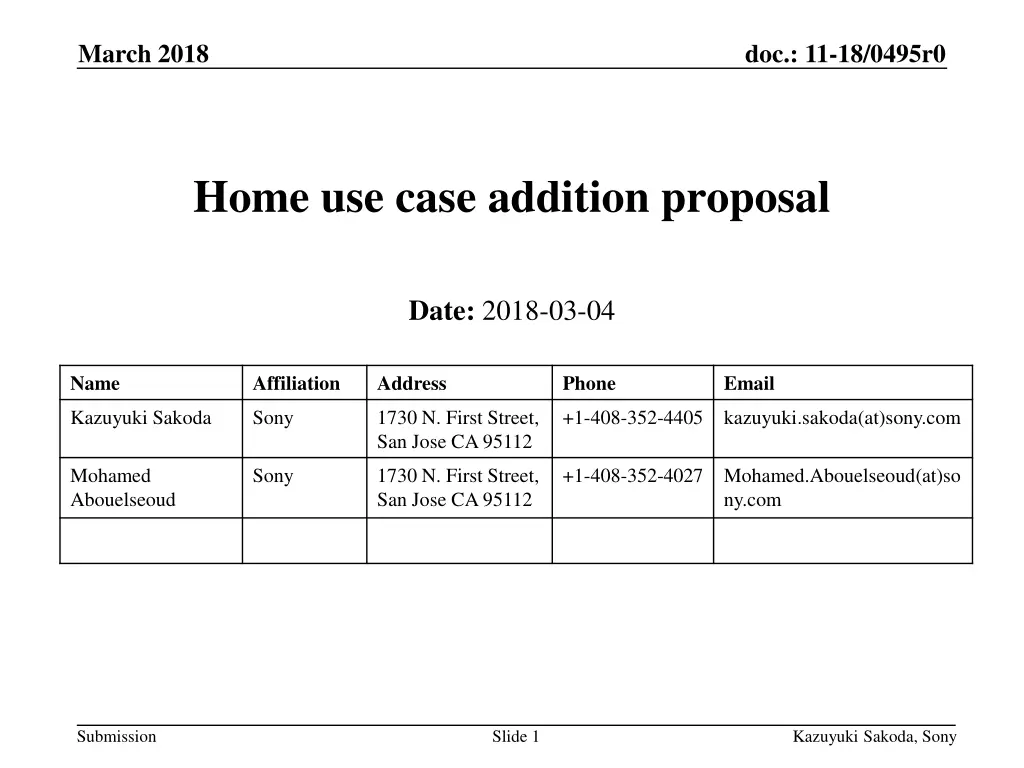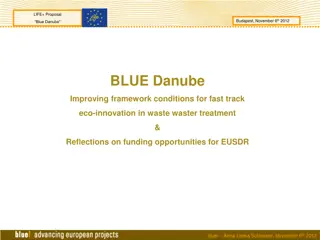
March 2018 Proposal for 802.11ay Home Use Case Addition
Explore the proposal for adding a home use case to the 802.11ay document, focusing on consumer device scenarios, motivation, and key attributes. The presentation covers potential considerations, distribution network use cases, and proposes additional use case scenarios for consumer devices, such as UHD video streaming and wireless transfers at smart homes. The usage model highlights the need for high data rates and robustness in streaming uncompressed 8K UHD content, with specific traffic conditions and environmental factors taken into account.
Download Presentation

Please find below an Image/Link to download the presentation.
The content on the website is provided AS IS for your information and personal use only. It may not be sold, licensed, or shared on other websites without obtaining consent from the author. If you encounter any issues during the download, it is possible that the publisher has removed the file from their server.
You are allowed to download the files provided on this website for personal or commercial use, subject to the condition that they are used lawfully. All files are the property of their respective owners.
The content on the website is provided AS IS for your information and personal use only. It may not be sold, licensed, or shared on other websites without obtaining consent from the author.
E N D
Presentation Transcript
March 2018 doc.: 11-18/0495r0 Home use case addition proposal Date: 2018-03-04 Name Affiliation Address Phone Email Kazuyuki Sakoda Sony 1730 N. First Street, San Jose CA 95112 +1-408-352-4405 kazuyuki.sakoda(at)sony.com Mohamed Abouelseoud Sony 1730 N. First Street, San Jose CA 95112 +1-408-352-4027 Mohamed.Abouelseoud(at)so ny.com Submission Slide 1 Kazuyuki Sakoda, Sony
March 2018 doc.: 11-18/0495r0 Agenda Motivation Recap on consumer device use cases Proposed addition to the 802.11ay use case document Submission Slide 2 Kazuyuki Sakoda, Sony
March 2018 doc.: 11-18/0495r0 Motivation 11-18/194r1 (distribution network use case for consumer devices) introduces additional considerations for home use case 11-15/625r7 (802.11 TGay usage scenarios) summarizes comprehensive potential use cases of 802.11ay. It might be useful to complement 11-15/625r7 with additional considerations in 11-18/194r1. This presentation includes proposal to the addition to 11-15/625r7 Submission Slide 3 Kazuyuki Sakoda, Sony
March 2018 doc.: 11-18/0495r0 Recap on consumer device use cases from 11-18/194r1 Use case Applicatio n Venue Range Bandwid th Latency Source (STB) UHD transfer Video streaming Indoor 5-10m (~20m) >Gbps <5msec Sink (Display) VR headset Video streaming Indoor 5-10m (~20m) >Gbps <5msec Camera video transfer Video streaming Indoor/ outdoor 10-50m <Gpbs <20msec Sink (Display) Source (Console) Sink (Headset) Blockers move Submission Slide 4 Kazuyuki Sakoda, Sony
March 2018 doc.: 11-18/0495r0 Key attribute Highlights from 11-18/194 Submission Slide 5 Kazuyuki Sakoda, Sony
March 2018 doc.: 11-18/0495r0 Usage Model 2: 8K UHD Wireless Transfer at Smart Home Pre-Conditions: 11ay is interfaced between a source device (e.g. set-top box, blu- ray player, tablet, smart phone) and a sink device (e.g. smart TV, thin display) to stream 8K UHD contents at home. Environment: Devices are operating in close proximity at home. Typical distance between devices are < 5m. When it comes to the link between a set-top box and a thin display (or smart TV), the set-top box can be inside a table which may provide some SNR loss. Source device and sink device might be located at places where LOS signal cannot reach Source device and sink device might be located at far side of the room and the link may experience human blockage Some users may try to install source device and sink device to different rooms Application: At least 28 Gbps data rate is required for a link to stream uncompressed 8K UHD streaming (60 frames per second, 24 bits per pixel, 4:2:2 Chroma sampling at minimum). Jitter <5ms, delay<5ms. Traffic Conditions Only a single link may exist at a time. There is typically minimum interference from other mm-wave links at home. Traffic is mostly unidirectional. Robustness is essential. Video streaming needs to be maintained continuously even when the link is obstructed or the D2D link bet ween source device and sink device is weak due to lack of link budget Proposed addition Use Case - Split TV: TV is on the wall as a thin display and set-top box works as a controller, wirelessly interfaced by 11ay to replace wired interfaces. -Smart display (Mirroring): Uncompressed 8K UHD streaming is through smart TV. 8K UHD video can be real-time transferred from Smartphone/tablet to smart TV. When user enters home, the video which the user is watching in his/her smart phone is seamlessly played in the smart TV. Capture from 11-15/625r7 Submission Slide 6 Kazuyuki Sakoda, Sony
March 2018 doc.: 11-18/0495r0 Usage Model 2: 8K UHD Wireless Transfer at Smart Home Requirements - Provides full rate >28 Gbps - High QoS/QoE (latency < 5ms, jitter<5ms) - P2P Sink (Display) Source (STB) https://encrypted-tbn1.gstatic.com/images?q=tbn:ANd9GcRLC5R5iSEz6MmQwFi4lrD0g7MG_1WyLuPFTSIbqQl1VFj1ajfDe4I0-g Replacement of wired interface Set-top box (TV controller) 8K UHD Service Wireless Transfer from fixed device https://encrypted-tbn3.gstatic.com/images?q=tbn:ANd9GcTIjdwqNoeakwq05XWf0cSoY9zD3wh9G-ykSTDk-CGB0PXQ11IYsK2a4QM Blu-ray player Source (STB) https://encrypted-tbn3.gstatic.com/images?q=tbn:ANd9GcQhHQMNWdGnqAK1ekRNjfgs8cg9uRghIdJRIJ0qMAgUMrcjNQ3o3YPbDJo TV or Display Wireless Transfer from mobile device Sink (Display) Smart phone/Tablet Proposed addition Sink (Display) Capture from 11-15/625r7 Submission Slide 7 Kazuyuki Sakoda, Sony
March 2018 doc.: 11-18/0495r0 Usage Model 3: Augmented Reality/Virtual Reality Headsets and Other High-End Wearables Pre-Conditions: Traffic Conditions: The high-end wearable (e.g. augmented reality/virtual reality headsets, high-def glasses, etc.) and its managing device (e.g. gaming console, smartphone, etc.) are equipped with 11ay interfaces and form a PBSS. All desired media content, processing power, and control needed by the high-end wearable resides on the managing device (i.e. internet connectivity not required). The D2D link may be obstructed (i.e. NLOS) and there may be significant interference from other 11ay users (e.g. other wearables, access points, etc.). Devices may be stationary or moving (pedestrian speed) while in use. Robustness is essential. Video streaming needs to be maintained continuously even when the link is obstructed or the D2D link is weak due to lack of link budget Application: User plays a game, watches a movie, etc. using his high-end wearable, which is communicating with the managing device (e.g. gaming console, smartphone). Both devices must be able to tolerate moderate user movement. Use Case: Public use case: 1. A passenger on a crowded commuter train is playing a game using his AR/VR headset and smartphone. Data rate at ~20 Gbps, latency < 5 ms, jitter <5 ms, PER<10E-2. 2. Some percentage of his fellow passengers are also playing a game using their AR/VR headsets and smartphones. Environment: The high-end wearable may be used at home or in public. At home, there are less than 4 interferers. In public (e.g. commuter train) there can be up to 120 interferers. Interferers have varying QoS requirements. 3. All passengers are semi-stationary, i.e. they shift and move in response to the game. 4. The QoS/QoE requirements of the gaming application are met. Transmissions (both desired signal and interference) can be LOS or NLOS. The D2D link between the high-end wearable and its managing device < 5 m. Home use case: User installed game console to a room and enjoy game with VR headsets. The link might experience human blockage. There might be multiple VR headsets in a room. Capture from 11-15/625r7 Submission Slide 8 Kazuyuki Sakoda, Sony
March 2018 doc.: 11-18/0495r0 Usage Model 3: Augmented Reality/Virtual Reality Headsets and Other High-End Wearables High-end wearables can be used at home and in public High-end wearable and its managing device may both be subject to low level movement Operating environment is usually indoor < 5 m AR/VR headsets touting close-to-reality user experience with 3D video and 7.1 audio Video quality can support up to 3D 4K Current products include Sony HMZ-T3 goggles and Oculus VR headsets Features Requirements Notes Distance 5 m Video Quality 3D 4K [1] HDMI 2.0 Range of Motion for head-worn wearable Neck Roll [2] 0.17 (s/60deg) Neck Pitch[2] 0.14(s/60deg) Neck Yaw[2] 0.13 (s/60deg) Device mobility Pedestrian speeds < 4km/hr No need to add here. Capture from 11-15/625r7 Submission Slide 9 Kazuyuki Sakoda, Sony
March 2018 doc.: 11-18/0495r0 Straw polls Do you think it is beneficial to include additional consideration in slide 6-8 to IEEE 802.11-15/625r7 IEEE 802.11 TGay Use Cases ? Yes: No: Don t care Submission Slide 10 Kazuyuki Sakoda, Sony
March 2018 doc.: 11-18/0495r0 References [1] IEEE 802.11-15/625r7 IEEE 802.11 TGay Use Cases , Rob Sun, et.al. [2] IEEE 802.11-18/194r0, Distribution network use cases for consumer devices , Kazuyuki Sakoda, et.al. Submission Slide 11 Kazuyuki Sakoda, Sony






















